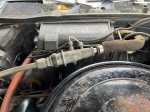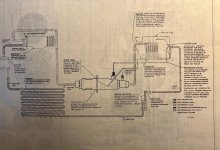I got a 1968 Electra Limited with AC. Last year the air was slightly cold, this year its not cold at all. Today I checked the pressure on the low side of the system, at the POA valve. Its was around 30 PSI. 30 PSI is what the service manual says is the right pressure
The air from the AC vents is not cold, BUT the POA valve on the pic below, gets really cold. The valve is locaded between the evaporator and the compressor low side so it the valve gets cold, the evaporator should get gold and cool the air.
Could it be a faulty expansion valve, a bad POA valve? or is the evaporator full of dirt so the air wont cool?
I think the system still is running on R12. Theres no signs of conversion to R134.
(And heater valve is shutted of)

The air from the AC vents is not cold, BUT the POA valve on the pic below, gets really cold. The valve is locaded between the evaporator and the compressor low side so it the valve gets cold, the evaporator should get gold and cool the air.
Could it be a faulty expansion valve, a bad POA valve? or is the evaporator full of dirt so the air wont cool?
I think the system still is running on R12. Theres no signs of conversion to R134.
(And heater valve is shutted of)




